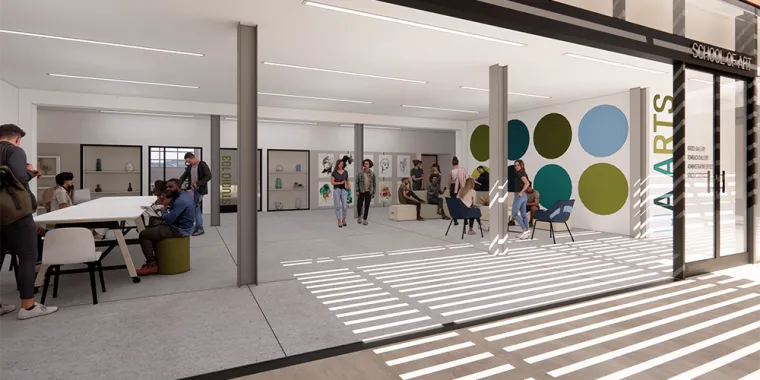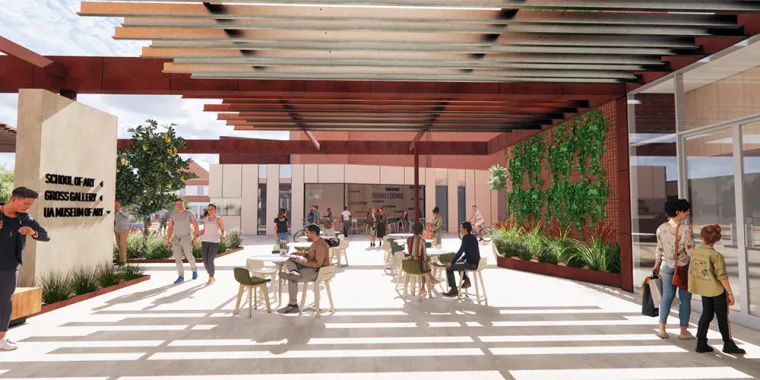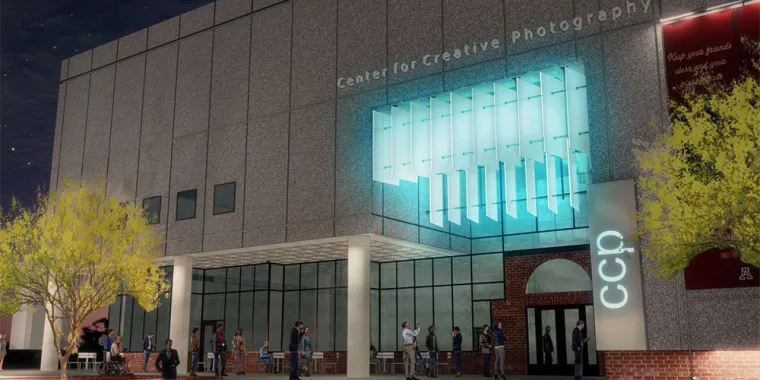Arts Gateway

On a sunny day in October 2021, the usual quiet shuffling and murmuring of students and visitors admiring art at the Center for Creative Photography was interrupted by the sounds of construction.
Workers had come to haul steel and fiberglass panels for the center’s new, more inviting facade — just one element in renovations planned for the Arizona Arts District, located near Speedway Boulevard and Olive Road.


Phase One of the Arizona Arts master plan calls for renovation of the buildings that house the School of Art and the School of Theatre, Film & Television. Noticeable changes include the facade at the CCP and improvements to the patron experience at the Marroney Theatre, home of the Arizona Repertory Theatre and the Next Performance Collective.
The cornerstone of the master plan and Phase One is a renovation of the Arts Oasis, the outdoor courtyard in the center of the Arts District. The vision includes a large canopy and newly designed, sustainable space for students and community members to enjoy.
In the near future, changes will begin at the University of Arizona Museum of Art and Centennial Hall. The planned projects are about more than saving historic buildings. They are part of the university’s strategic plan, which calls for infusing the arts into all aspects of the university and investing in the arts as a gateway to the university.
The strategic plan “elevates the arts as central to the UArizona experience in all kinds of ways, in the classroom and campus-wide,” says Andy Schulz, vice president for the arts and dean of the College of Fine Arts. It includes not only ways to connect students to the arts — from music to dance to theater to visual art — but also the local community.
And, Schulz notes, it includes the needs of the aging buildings, which had not been updated for many years. The renovations and upgrades have happened thanks to gifts from donors and friends of the arts.


“I am so excited to see Phase One of the Arts master plan underway,” says University of Arizona President Robert C. Robbins. “The University of Arizona has an incredible variety of the arts and cultural offerings available, and this construction is the first step to advancing creativity-based education, innovative research and community engagement.”
The Arizona Arts master plan was approved in March 2020 — just as the pandemic hit campus, upending initial timelines. The renovations were delayed, but in the summer of 2021, the sounds of jackhammers, power drills and forklifts began to fill the air.
The School of Art, the first building to get a makeover, has had drab, narrow corridors and inward-looking spaces for decades, says School Director Colin Blakely. “The studios were cramped and fragmented, and in many cases outdated, and there were no hangout spaces for the students. A student gallery was tucked out of sight. We want outward-looking spaces to engage students and the broader public,” he says.
An elaborate renovation, now nearly finished, has modernized sections of the school’s first and second floors and created an indoor/outdoor courtyard gathering space. The reconfigured Lionel Rombach Gallery will feature student artwork and, with its new windows, will allow the pieces to be visible from outdoors.
The school typically has nearly 550 majors. Counting non-majors, the faculty teaches about 2,000 students across campus each semester. And Blakely hopes to invite students who are not involved in the arts to see how special the arts campus is. Nearby, the beloved Marroney Theatre, built in 1956, will undergo a makeover starting in 2022.
“We will renovate and modernize the interior of the theater,” says Andy Belser, director of the School of Theatre, Film & Television. “We’ll have a new, beautiful glass lobby that will offer patrons a totally different experience while providing space for theater and film festival receptions.”
Thanks to technology upgrades, students will learn in a new performance space with increased technology with updates to the technical aspects of acting, design, filmmaking and more. Among the goodies will be a digital laser projector which will turn the Marroney Theatre into a high-end screening room.
“We are doing really well,” Belser says, pointing out that many graduates go on to careers on Broadway stages, in TV and in Hollywood. “What we’re lacking is technology. The updated Marroney will help us to merge and expand our programming for our acclaimed theater and film programs.”
The unifying vision of the Arizona Arts master plan will create connections within the Arts District, which includes the Center for Creative Photography.
As part of Phase One, CCP’s entrance has been reimagined. It now connects with its arts partners across the way on Olive Road. Its new facade features fiberglass panels lit by LED lights streaming in sunlight by day and reflecting color by night. This facade and new signage have inspired plans to enhance the patio with new furniture to make it an even more welcoming space.
“Our overarching goal is to make the University of Arizona an arts destination for the benefit of our students and the communities of southern Arizona,” notes Schulz.
